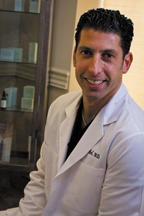
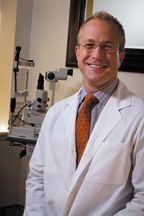
Ari D. Abel, MD & Bryan D. Seiff, MD
The most common patient complaint we hear in oculofacial plastic surgery is about ?droopy eyelids?.
But what does a patient mean when he or she complains that the eyelids are ?drooping?? What treatments are available to correct this problem? And when does this ?drooping? cease to be a cosmetic concern and become a true functional problem?
In order to understand this problem and how to fix it, we must first define what is meant by ?droopy eyelids?. This complaint may mean different things to different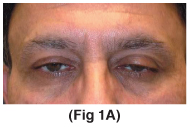 people, and identifying a patient?s specific concern is important because the techniques for fixing these problems will differ accordingly. True ?droopy eyelids?, referred to as Ptosis in the medical literature, occur when the eyelid lifting muscle or its corresponding tendon is weakened and the lid itself hangs lower than normal (Fig 1A). Ptosis may be caused by dysfunction of the eyelid muscle or the nerve which supplies it, but is most commonly a result of wear and tear on the tendon. If the eyelid hangs low enough it may obscure the pupil, thereby affecting the patient?s peripheral vision.
people, and identifying a patient?s specific concern is important because the techniques for fixing these problems will differ accordingly. True ?droopy eyelids?, referred to as Ptosis in the medical literature, occur when the eyelid lifting muscle or its corresponding tendon is weakened and the lid itself hangs lower than normal (Fig 1A). Ptosis may be caused by dysfunction of the eyelid muscle or the nerve which supplies it, but is most commonly a result of wear and tear on the tendon. If the eyelid hangs low enough it may obscure the pupil, thereby affecting the patient?s peripheral vision.
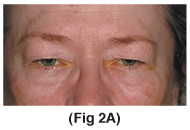 Dermatochalasis is a condition in which the eyelid skin has thinned and lost its elasticity and subsequently hangs over the eyelashes and lid margin (Fig 2A). As this tissue thins, fat may also begin to prolapse into the upper eyelid space. Once these tissues have descended past the lid margin, they can obstruct the patient?s peripheral vision. They may also displace the eyelashes downward and cause irritation of the eye. In certain cases, this condition can be worsened by gravitational descent of the thicker eyebrow tissue, pushing the eyelid tissues even further down.
Dermatochalasis is a condition in which the eyelid skin has thinned and lost its elasticity and subsequently hangs over the eyelashes and lid margin (Fig 2A). As this tissue thins, fat may also begin to prolapse into the upper eyelid space. Once these tissues have descended past the lid margin, they can obstruct the patient?s peripheral vision. They may also displace the eyelashes downward and cause irritation of the eye. In certain cases, this condition can be worsened by gravitational descent of the thicker eyebrow tissue, pushing the eyelid tissues even further down.
When ptosis or dermatochalasis becomes severe enough, it can obstruct the patient?s peripheral vision and begin to affect his or her daily activities. Common complaints include difficulty with driving or reading. These are more noticeable at night as ambient light levels decrease, and as compensatory forehead and accessory lifting muscles begin to fatigue. Many patients will state that they can see better when manually elevating their eyelids. In order to document these changes, photographs can be taken which demonstrate obstruction of the pupil by the eyelid or by redundant skin. In addition, visual field testing can be performed to document the degree of visual field loss. Patients that do not have any visual complaints but wish to improve the overall appearance of their eyelids may choose to undergo these procedures on an elective basis.
 Correction of drooping eyelids is usually surgical. Ptosis is corrected by
Correction of drooping eyelids is usually surgical. Ptosis is corrected by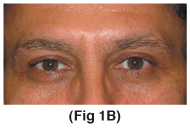 tightening the eyelid muscle and its corresponding tendon, either through an external incision at the eyelid crease or an internal incision on the underside of the eyelid (Fig 1B). Dermatochalasis is improved by removing the redundant eyelid tissue through a lid crease incision, a procedure known as a blepharoplasty (Fig 2B). If the brow has descended and is contributing to the drooping eyelid, it can be lifted at the same time. These procedures are performed on an outpatient basis, usually under light to moderate sedation.? Patients are advised to avoid any heavy lifting or strenuous exercise for approximately one week, but may otherwise resume their normal activities, including driving, the very next day. Ice is used for several days to minimize bruising, and ointment is placed on the incisions for approximately 2-3 weeks to aid in healing. Stiches dissolve or are removed at one week.
tightening the eyelid muscle and its corresponding tendon, either through an external incision at the eyelid crease or an internal incision on the underside of the eyelid (Fig 1B). Dermatochalasis is improved by removing the redundant eyelid tissue through a lid crease incision, a procedure known as a blepharoplasty (Fig 2B). If the brow has descended and is contributing to the drooping eyelid, it can be lifted at the same time. These procedures are performed on an outpatient basis, usually under light to moderate sedation.? Patients are advised to avoid any heavy lifting or strenuous exercise for approximately one week, but may otherwise resume their normal activities, including driving, the very next day. Ice is used for several days to minimize bruising, and ointment is placed on the incisions for approximately 2-3 weeks to aid in healing. Stiches dissolve or are removed at one week.
Both Drs. Abel and Seiff are Oculofacial Plastic surgeons, meaning they specialize in the delicate tissues of the eyelid and surrounding structures.
If you think you may be a candidate for any of these procedures, or would like any information regarding other services available, they can be contacted at the
Abel Center for Oculofacial Plastic Surgery at 302-998-3220.
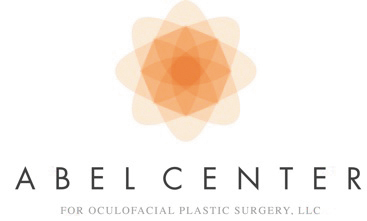
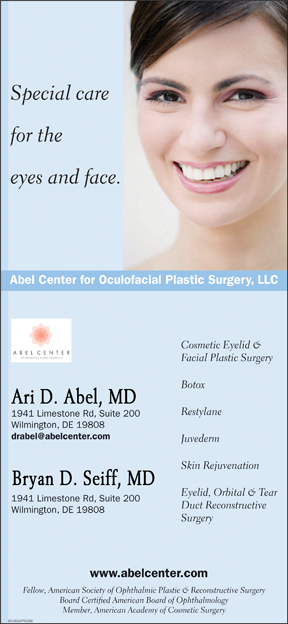
Dr Abel is one of approximately 400 Oculofacial Plastic Surgeons in the United States. An Oculofacial Plastic Surgeon is Board Certified by the American Board of Ophthalmology and a Fellow of the American Society of Ophthalmic Plastic and Reconstructive Surgery. Dr. Abel is also a member of the American Academy of Cosmetic Surgery. He specializes in the treatment of eyelid, brow and other facial dysfunctions. He is skilled in the removal of tumors and the repair of ocular and facial trauma. He has many years of experience in aesthetic facial surgery, skin rejuvenation, as well as Botox and wrinkle fillers.
Dr. Abel received his medical degree from Jefferson Medical College in Philadelphia, PA and completed his residency in Ophthalmology at Johns Hopkins University in Baltimore, MD. He conducted a two-year fellowship in Ophthalmic and Facial Plastic Surgery at the Albany Medical Center in Albany, NY. Dr. Abel also has a profound interest in medical missions for developing countries, which most recently included trips to India and Nepal.
Dr. Seiff is one of approximately 400 Oculofacial Plastic Surgeons in the United States. An Oculofacial Plastic Surgeon is Board Certified by the American Board of Ophthalmology and a Fellow of the American Society of Ophthalmic Plastic and Reconstructive Surgery. He specializes in the treatment of eyelid, brow and other facial dysfunctions. He is skilled in the removal of tumors and the repair of ocular and facial trauma. Dr. Seiff also has a strong interest in aesthetic care. This area of his practice includes aesthetic facial surgery, skin rejuvenation, as well as Botox and wrinkle fillers. Dr. Seiff graduated first in his medical school class at UMDNJ and completed his ophthalmology training at Cornell. He then completed his two-year oculoplastic fellowship at Univ. California-San Francisco.
Source: http://thewomensjournal.com/20121201/help-my-eyelids-have-fallen/
gaslight justin timberlake michael dyer bachmann bachmann iowa caucus results sickle cell trait
No comments:
Post a Comment